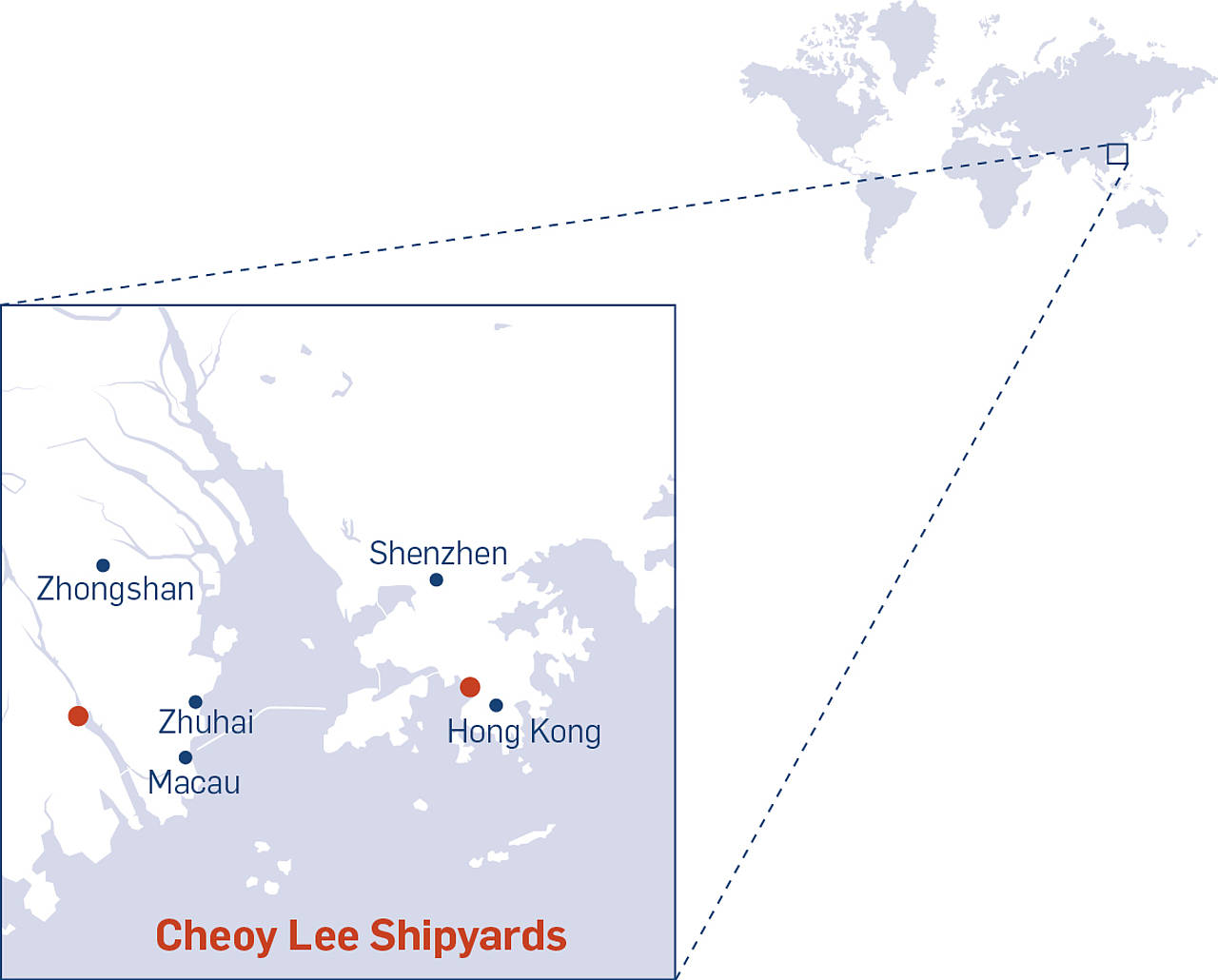Hong Kong-based Cheoy Lee Shipyards was founded roughly 100 years ago. An impressive 5,200 ships of all types have set sail from the shipyard since. The company’s long history and remarkable success are a result of its effective strategies and constant revitalization
The 100-year-old shipbuilding company was first established in Shanghai and moved to Hong Kong in 1936. Cheoy Lee Shipyards (CLS) then became a limited liability company in 1976. Owned by the Lo family, whose ancestors originate from Guangzhou, China, the fourth and fifth generations of the family currently run the company. They follow the time-honoured traditions of the first three generations of the family’s shipwrights and shipbuilders, who constructed harbour and coastal vessels in wood, steel and then fiberglass and aluminium – initially with steam, then with diesel engines.
Cheoy Lee has two facilities in China: its corporate headquarters and an adjoining shipyard in Hong Kong. The latter was built by the company and is mainly designed for new vessel deliveries and local ferry repairs. The main production site is strategically located on the Pearl River in the Doumen District of Zhuhai in the Guangdong Province, just 45 miles to the west of Hong Kong. It is a 90-minute drive from the city via the recently opened Hong Kong-Zhuhai-Macao Bridge.
This modern shipyard was created in 1999 when Cheoy Lee vacated its premises in Penny’s Bay to make way for the world-famous Hong Kong Disneyland. It still operates in the same location today. During the early years in Hong Kong, the shipyard constructed steel and wooden commercial vessels for local and Southeast Asian countries. By the mid-1950s, Cheoy Lee diversified to produce teak-wood sailing yachts, most of which were exported to the United States.
When fiberglass emerged as a shipbuilding material in the 1960s, the company took advantage. It began building sailing yachts in earnest, eventually becoming a well-known brand worldwide. A Sales and Aftersales office was eventually established in Fort Lauderdale, Florida to serve the Yacht division’s customers. Cheoy Lee commercial vessels continued to be built predominantly in steel and aluminium, with the 1990s seeing a strong resurgence in the shipyard’s commercial vessel output.
Since relocating to Hong Kong 86 years ago, the company has constructed and delivered more than 5,200 vessels, many of which are still operating for satisfied customers across all continents. Within the past five years alone, approximately 150 tugs, crew boats, wind farm service vessels, pilot boats, yachts, and other vessel types have left the shipyard.
This enormous output requires production facilities of a sufficiently large size. The 116,000 m² (30-acre) Hin Lee (Zhuhai) Shipyard facility includes a 1,000-ton railway lift, 150-ton Travelift, dedicated fabrication halls for steel, aluminium and fiberglass moulding, dust-free painting halls, trade-specific workshops along with dormitories to house up to 1,000 employees. The site is packed with advanced production machinery capable of producing vessels up to 70 metres (230 feet) in length. This includes Prop Scan equipment, five-axis CNC cutters, milling, rolling, and bending machines, lathes up to eight metres (26 feet) in length, NC water bath plasma cutters and much more.
As one of the world’s only yards to routinely manufacture in steel, fiberglass, aluminium and various combinations of these materials, Cheoy Lee builds to globally recognized standards and regulations. CLS’ collaboration with naval architectural firm Robert Allan Limited is of particular note, as it has helped the tug-building program to become one of the recognized global leaders in azimuth stern drive (ASD) harbour tug production. Cheoy Lee’s first collaboration with the architects, a 60-ton bollard pull Z-Tech tug, was launched in 2004. Over the ensuing years, CLS has made a further 160 units of tugs designed by Robert Allan, and the relationship continues to grow to this day.
SCHOTTEL is also on board with Cheoy Lee, with more than 370 thrusters installed in over 180 of their vessels. “The most remarkable ship that CLS recently built with SCHOTTEL products is probably The Jackson,” CLS Director Ken Lo says. “The 63-metre dinner cruise ship for Captain Cook in Sydney is fitted with SCHOTTEL electric azimuth thrusters and a bow thruster.” The cooperation with SCHOTTEL started back in the early 1990s, with many landmark projects taking off since.
As Ken Lo recalls: “The Z-Tech tug series created by PSA Marine and Robert Allan in 2003 started the relationship between SCHOTTEL and Cheoy Lee in a big way, when our company was successfully securing the contracts from PSA,” he says. “The Z-Tech was the topic of a paper at the ITS in Miami in 2004 and attracted the attention of the Panama Canal, who eventually had 21 Z-Tech tugs built by Cheoy Lee.” CLS tugs are certainly well known elsewhere in the market. “They are owned and operated by most of the major tug owners: Svitzer, Boluda, Kotug, SAAM, Boskalis, CPT, to name just a few,” says Ken Lo.
How would the company’s Director characterize working with SCHOTTEL? “Cheoy Lee’s cooperation with SCHOTTEL has been excellent throughout the years, ever since we started building ASD tugs in 2003. SCHOTTEL azimuth drives are installed in most of our tugs, way more than other brands.” He adds the main arguments for cooperation are the reliability and attentive service, which result in minimal downtime.
Cheoy Lee’s corporate strategy is always aligned with future trends – a major factor in the company’s success. There is currently a strong focus on dual fuel, hybrid solutions, and aspects relating to environmentally friendly tugs. “However, ASD is still predominant with bollard pulls in the 70- to 90-ton range,” Ken Lo adds. Demand is greater than supply right now and the premium tug-builders are having a hard time trying to deliver the required tonnage.
In addition to the technical focus, Ken Lo wants to expand in regional sales markets: “We are selling worldwide, but the latest trend seems to be heading towards developing regions such as Bangladesh, Sri Lanka, Africa, and Central and South America for port- and LNG-related projects.”
